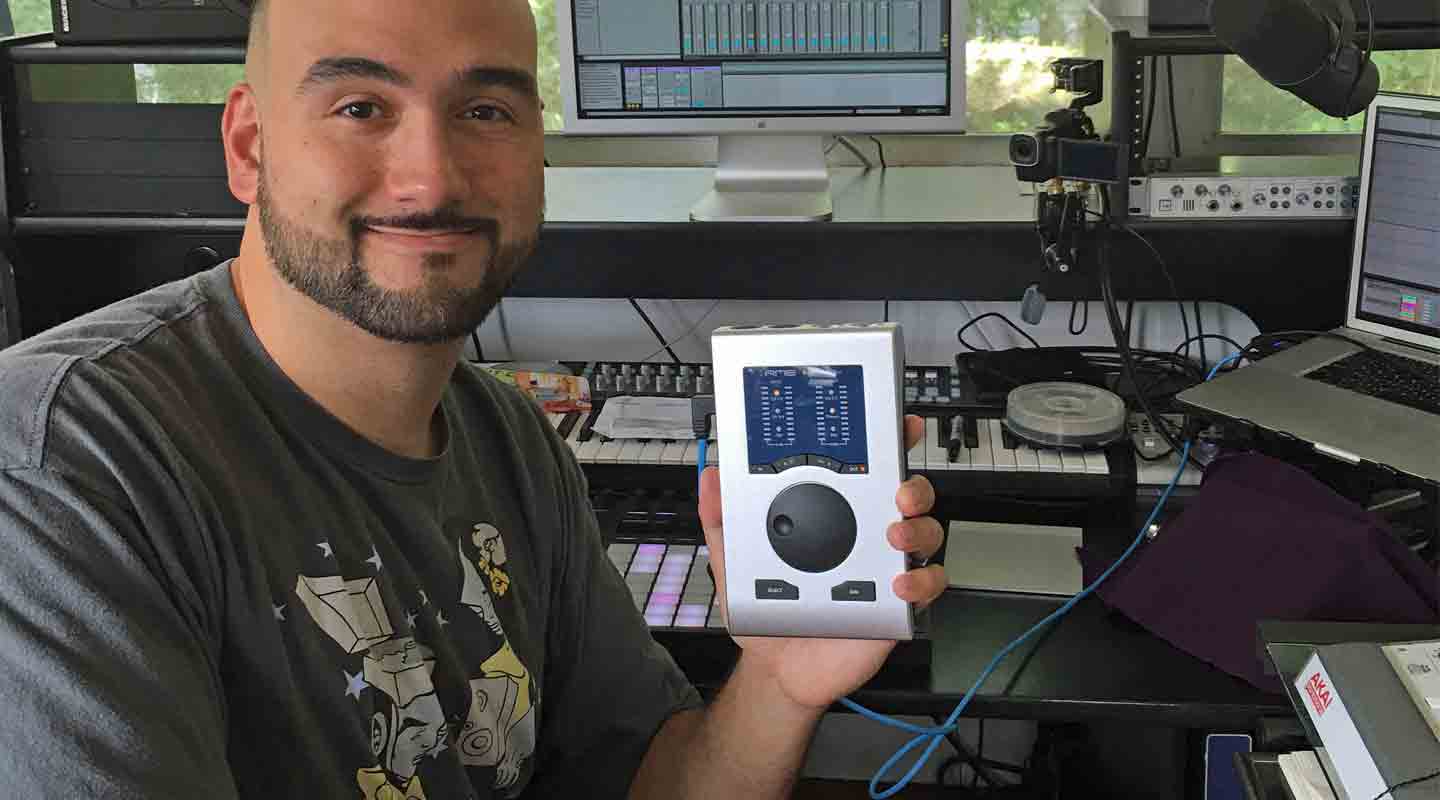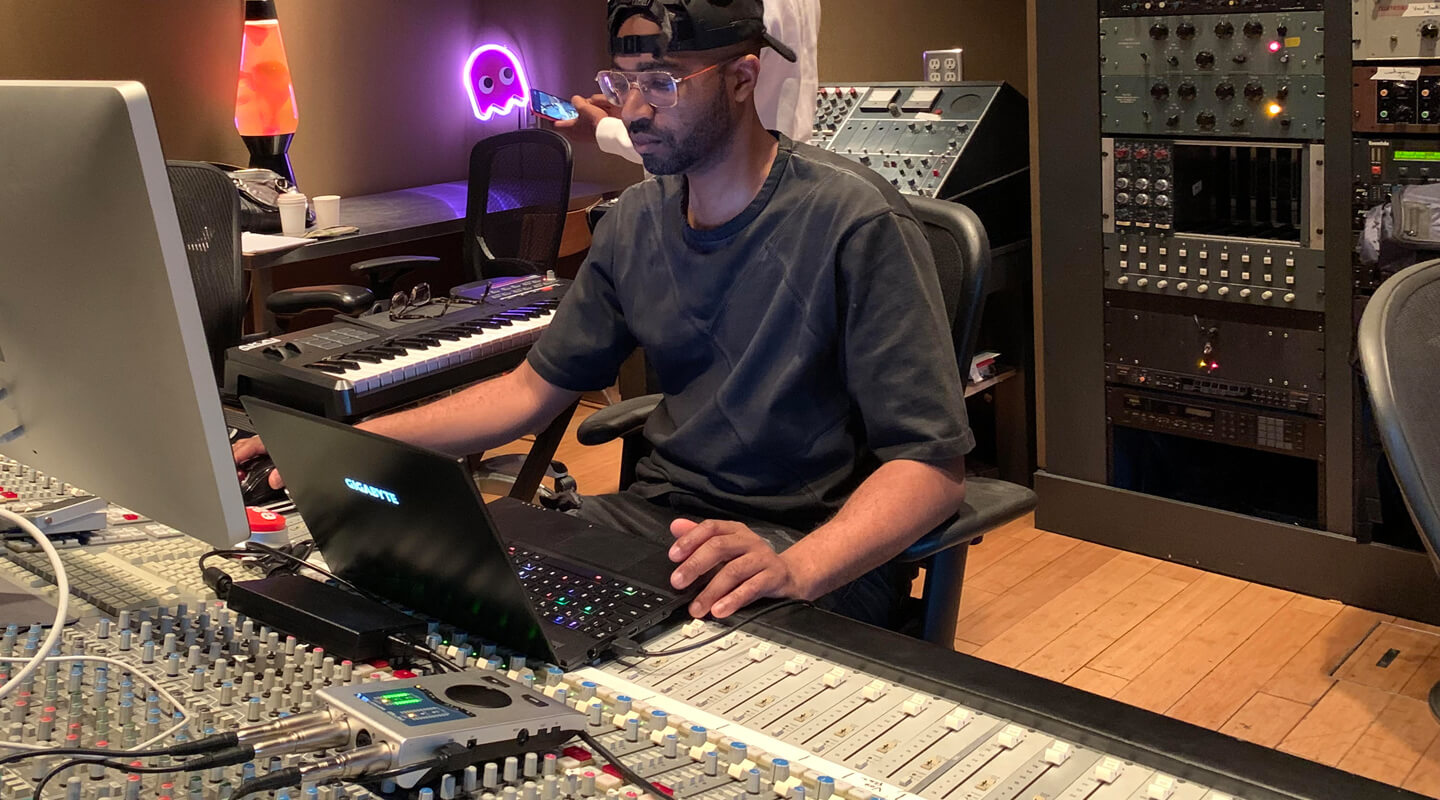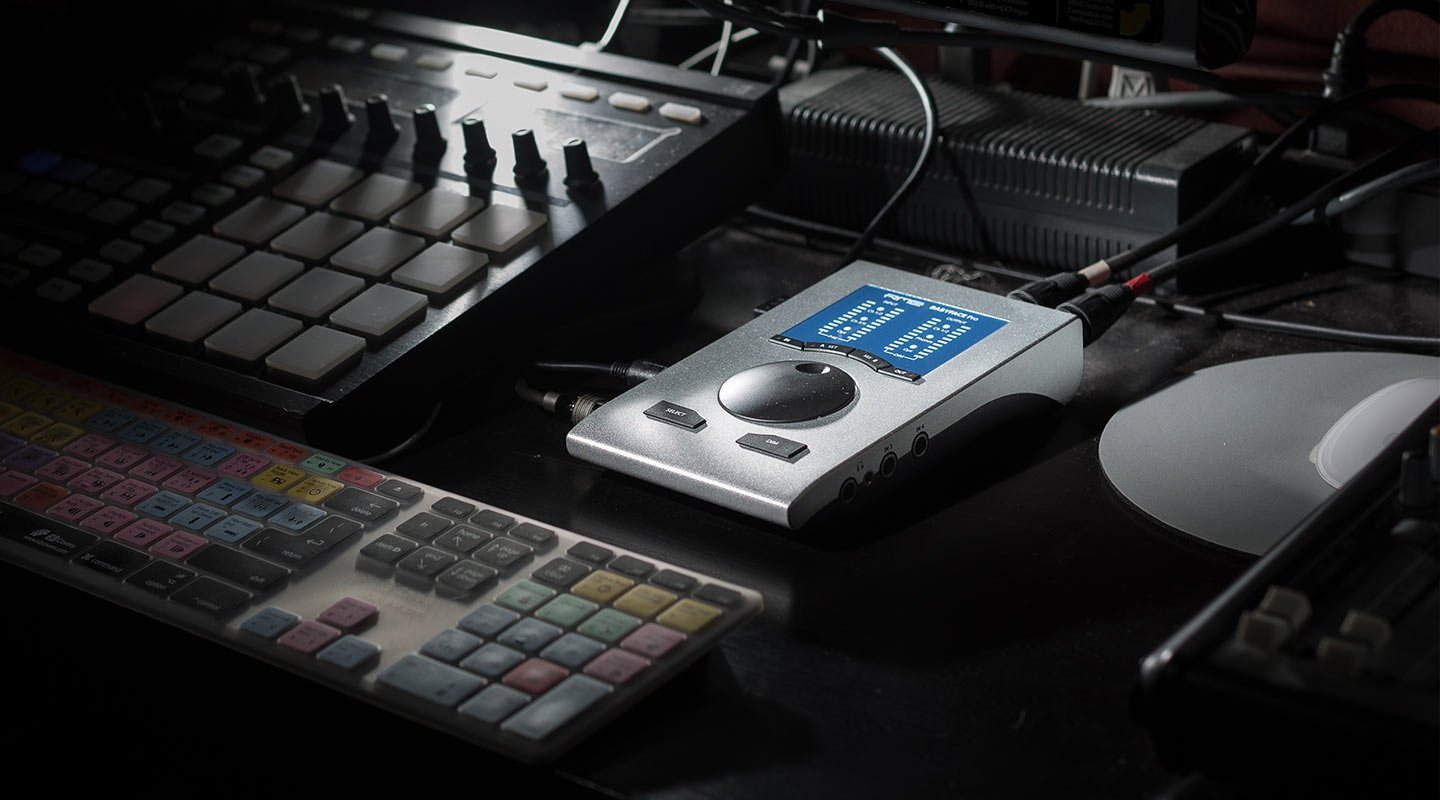Babyface Pro FS
24-Channel 192 kHz bus-powered professional USB 2.0 Audio Interface
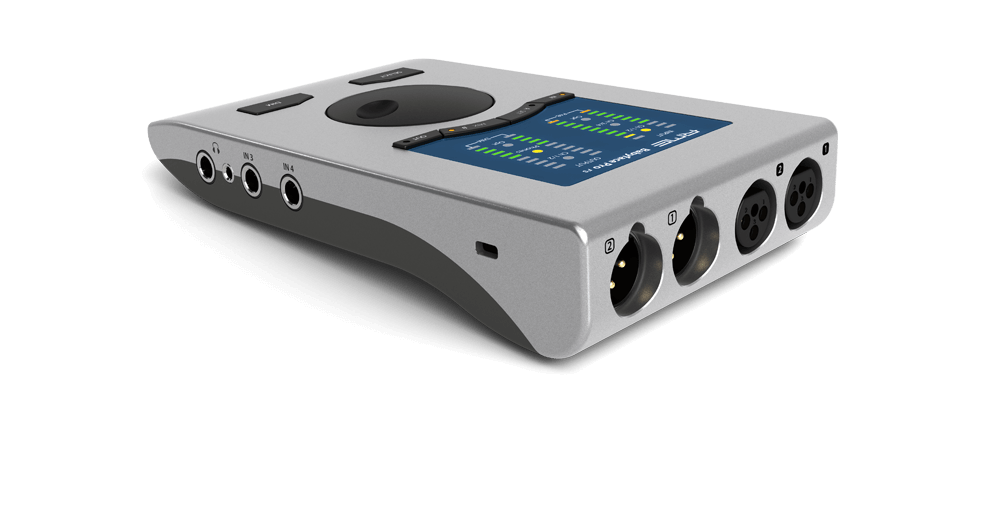
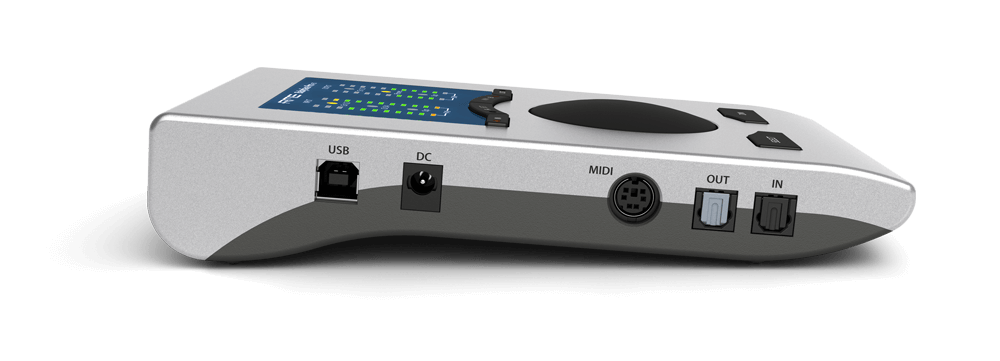
Connectivity and Features
ADI-2 Series Headphone Power
The two headphone outputs, offering TRS and mini-jack sockets in parallel, have completely separate driver stages to perfectly match low and high impedance headphones, guaranteeing pristine sonic results no matter what type of headphone is used.
The 3.5 mm TRS phones output power rises to 90 mW. THD of both phones outputs improved by up to 10 dB. and uses same output op-amps as ADI-2 Pro now. Finally the output impedance of 3.5 mm TRS was lowered from 2 Ohms to 0.1 Ohms.
Full range capture - Improved Mic & Line Inputs
For the main I/O RME have designed a XLR socket, which integrates seamlessly into the housing and saves space. Two digitally controlled preamps provide individually switchable 48V phantom power. These circuits feature a gain range of 76 dB, adjustable in steps of 1 dB, including a relay-driven PAD, resulting in exceptional EIN (Equivalent Input Noise) performance as well as line overload protection, and enough gain for even the lowest level microphones.
Babyface Pro’s incredibly efficient design almost never requires an external power supply – it’s perfectly stable on USB 3 bus power, and also most USB 2 ports, with no degradation in any technical specification. This makes it perfect for mobile recording, even with a pair of your favourite condenser microphones.
The comprehensive feature set continues with an optical TOSLINK I/O; use as either an ADAT port with SMUX support or SPDIF for sessions up to 192 kHz. In combination with an external ADAT converter, the Babyface Pro fully supports 12 analog inputs as well as 12 outputs, making it ideal for both live and studio multi-track applications. You can plug any instrument, line or high impedance, into Babyface Pro’s jack inputs 3 & 4. Record your guitar on the go, with no additional hardware required. MIDI I/O via an included breakout cable completes the package.
More Pro level Performance with SteadyClock FS
In digital audio, the clock frequency is an essential factor, as it creates the correlation between the audio bits and the time reference. Unfortunately, the clock frequency is not always as stable as desired. The Babyface Pro FS offers the full SteadyClock FS circuit as in the ADI-2 Pro FS for lowest jitter and highest jitter immunity. Excellent performance in all clock modes and High Quality Analog Conversion to hear your mix as it is. Digital format conversion in RME products are done without any loss or degredation,and SteadyClock FS ensures your sonic image will never experience degredation. This helps to optimize recordings and mixes because the soundstage has more depth and clarity.
Mixing & Routing with TotalMix FX & TotalMix Remote
Like all the latest RME interfaces, the Babyface Pro FS also includes the powerful digital real-time mixer TotalMix FX. It allows fully independent routing and mixing of input and playback channels to all physical outputs. Independent stereo submixes plus a comprehensive Control Room section offer unrivalled monitoring capabilities and unsurpassed routing flexibility.
Babyface Pro FS ships with RME’s TotalMix FX, available for Windows and Mac OS X. An iOS version is available as well. This amazingly versatile software allows you to use Babyface Pro in any situation. For example mixing your guitar and vocals to headphones has never been easier. The FPGA-based DSP mixer adds a flexible, 3-band parametric equalizer to all inputs and outputs. The Babyface Pro FS also provides a separate FX send bus for all inputs and software playback channels, feeding two effect engines: Reverb and Echo. Every output channel includes a FX return control for the FX output signal (Effects are not available for operation in stand-alone and iOS mode).
Additionally RME’s latest software, TotalMix Remote, enhances the power of the Babyface Pro FS by enabling remote control via iOS, PC or Mac. With a straightforward set up process — simply enter the IP address of the computer you would like to control with TotalMix Remote and get going — users can quickly adjust any aspect of TotalMix FX on a host system while walking around the studio with their tablet, or from a control room located elsewhere in the facility.
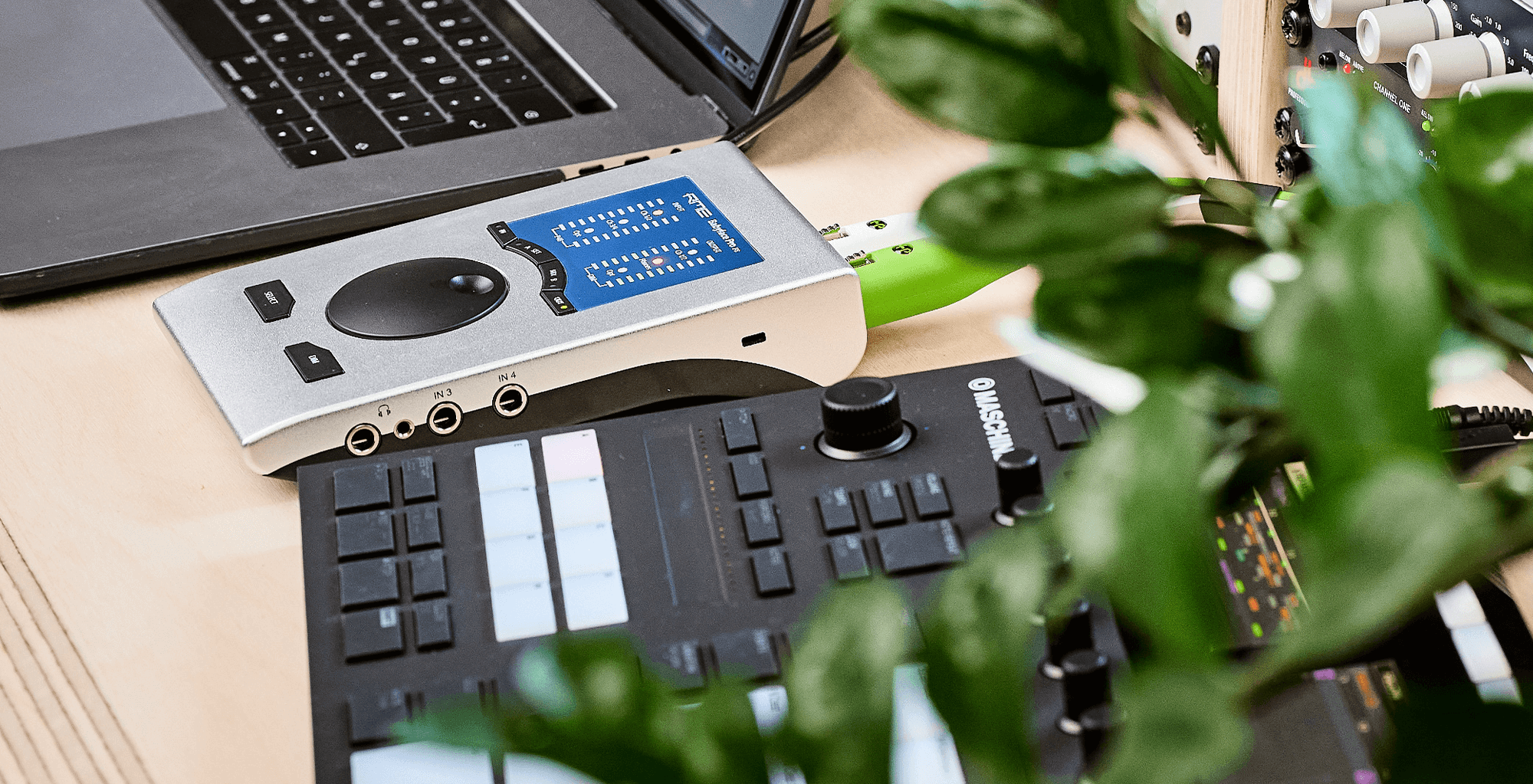
The FPGA-based DSP mixer adds a flexible, 3-band parametric equalizer to all inputs and outputs. Reverb and delay FX are also available. Latest generation low latency AD/DA converters, combined with RME’s unique SteadyClock FS technology, result in exceptional specifications that will satisfy the most demanding of professionals. Combining a huge feature set with sonic excellence and intuitive control, whether for the studio or on the move, the RME Babyface Pro is the most comprehensive and versatile compact audio interface ever built.
Versatile, Portable and Expandable

Straight to the core without interference: the reference design of the Babyface Pro leaves nothing to be desired. RME devices are designed to conserve music as it is. Audio signals are passed in their entirety, nothing added, nothing taken. For the new Babyface, the audio circuits have been improved to meet even highest gain levels with best dynamic range. The clever user interface is informative and clearly laid out. It makes access to every feature and configuration mode of the Babyface Pro intuitive and easy to use.
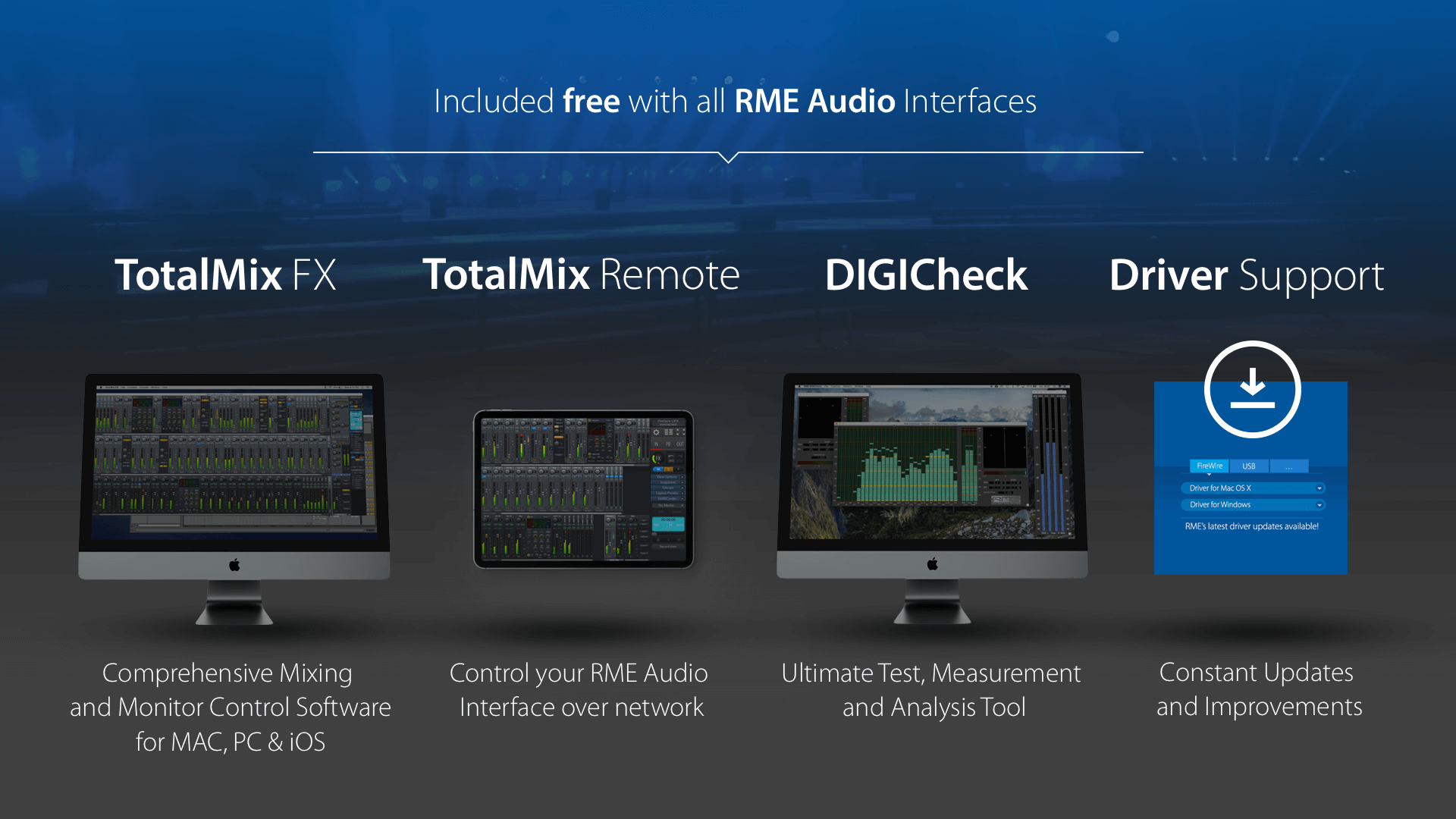
RME USB - Transport audio with lowest latency and industry leading stability
As part of RME’s product philosophy, we always further develop and optimize our core technology. RME have paved the way for multichannel audio and were the first to deliver professional performance over USB 2.0. We place a high level of attention on the development of reliable, stable, and regularly updated drivers for our products and an unwavering focus on audio quality. This guarantees your Babyface Pro FS will be never outdated and always updated.
And because RME Audio develops its own interface core, it’s not dependent on 3rd parties for upgrades, modifications or bug fixes, so customers can use latest operating systems without interruption or delay.
SteadyClock FS - Reference class Digital Clocking
Excellent performance in all clock modes and High Quality Analog Conversion to hear your mix as it is, with lowest jitter and highest jitter immunity.
TotalMix FX - Mixing/Routing with superior features for Studio and Live Work
Since 2001 TotalMix added unlimited routing and mixing to RME‘s audio interfaces. Its unique capability to create as many independent submixes as output channels available turned it into the most flexible and powerful mixer of its kind.
DigiCheck - The Secret Weapon of High Resolution Audio Measurements
RME Audio interfaces not only provide you with a professional digital audio interface, but also with a free available software tool: DigiCheck, for metering, testing, measuring and analyzing digital audio streams.
RME USB - Transport audio with lowest latency and industry leading stability
Use your RME audio interface on Mac and PC with reliable, stable, and regularly updated drivers for our products. RME Audio develops its own interface core, it’s not dependent on 3rd parties for upgrades, modifications or bug fixes, so customers can use latest operating systems without interruption or delay."
Specs
Babyface Pro FS
Analog
AD, Microphone/Line 1-2
- Input: XLR, electronically balanced
- Input impedance balanced: 2 kOhm, 5.2 kOhm with PAD
- Input impedance unbalanced: 1 kOhm, 2.6 kOhm with PAD
- Signal to Noise ratio (SNR): 113,7 dB RMS unweighted, 117 dBA
- Frequency response @ 44.1 kHz, -0.1 dB: 18 Hz – 20.8 kHz
- Frequency response @ 96 kHz, -0.5 dB: 7 Hz – 45.8 kHz
- Frequency response @ 192 kHz, -1 dB: 5 Hz – 88 kHz
- With PAD active : -0.1 dB 8 Hz, -0.5 dB < 4 Hz, -1 dB < 3 Hz
- THD: < -112 dB, < 0.00024 %
- THD+N: < -108 dB, < 0.00035 %
- THD @ 30 dB Gain: < -115 dB, < 0.00016 %
- THD+N @ 30 dB Gain: < -100 dB, < 0.001 %
- Channel separation: > 110 dB
- Gain range: -11 dB up to +65 dB
- Maximum input level XLR, Gain 0 dB: +8 dBu, PAD +19 dBu
- Maximum input level XLR, Gain 65 dB: -57 dBu, PAD -46 dBu
AD, Line/Instrument In 3-4
As Microphone/Line 1-2, but:
- Input: 6.3 mm TS jack, unbalanced
- Input impedance: 1 MOhm
- Signal to Noise ratio (SNR): 116 dB RMS unweighted, 120 dBA
- Frequency response @ 44.1 kHz, -0.1 dB: 5 Hz – 20.8 kHz
- Frequency response @ 96 kHz, -0.5 dB: < 3 Hz – 45.8 kHz
- Frequency response @ 192 kHz, -1 dB: < 2 Hz – 92 kHz
- Maximum input level @+4 dBu, Gain 0 dB: +13 dBu
- Maximum input level @-10 dBV, Gain 9 dB: -5 dBu
DA, Line Out 1-2
- Dynamic range (DR): 115 dB RMS unweighted, 118 dBA
- Frequency response @ 44.1 kHz, -0.5 dB: 0 Hz – 20.8 kHz
- Frequency response @ 96 kHz, -0.5 dB: 0 Hz – 45 kHz
- Frequency response @ 192 kHz, -1 dB: 0 Hz - 89 kHz
- THD: - 106 dB, 0.0005 %
- THD+N: -102 dB, 0.0008 %
- Channel separation: > 110 dB
- Output: XLR balanced
- Output impedance: 300 Ohm balanced, 150 Ohm unbalanced
- Output level @ 0 dBFS: Balanced +19 / +4 dBu, unbalanced +13 / -2 dBu
- DC @ 0 dBFS: 6.35mm 4.8 V, 3.5mm 2.4 V, XLR bal. 9.6 V
DA, Phones 3/4
AS DA Line Out, but:
- Output: 6.3 mm TRS jack, unbalanced
- Output impedance: 10 Ohm
- Output level at 0 dBFS, 1 kOhm load: +13 dBu
- Max power @ 0.1% THD: 60 mW
- Signal to Noise ratio (SNR): 114.8 dB RMS unweighted, 118 dBA
- Noise level: -101.8 dBu
- Output: 3.5 mm TRS jack, unbalanced
- Output impedance: 0.1 Ohm
- Output level at 0 dBFS, 1 kOhm load: +7 dBu
- Max power @ 0.1% THD: 90 mW
- Signal to Noise ratio (SNR): 114 dB RMS unweighted, 117 dBA
- Noise level: -107 dBu
MIDI
- 1 x MIDI I/O via breakout cable with 2 x 5-pin DIN jacks
- Galvanically isolated by optocoupled input
- Hi-speed mode: Jitter and response time typically below 1 ms
- Separate 128 byte FIFOs for input and output 25.3
Digital
- Clocks: Internal, ADAT In, SPDIF In
- Jitter suppression of external clocks: > 50 dB (2.4 kHz)
- Effective clock jitter influence on AD and DA conversion: near zero
- PLL ensures zero dropout, even at more than 100 ns jitter
- Digital Bitclock PLL for trouble-free varispeed ADAT operation
- Supported sample rates: 28 kHz up to 200 kHz
Digital Inputs
ADAT Optical
- 1 x TOSLINK
- Standard: 8 channels 24 bit, up to 48 kHz
- Double Speed (S/MUX): 4 channels 24 bit 96 kHz
- Quad Speed (S/MUX4) : 2 channels 24 bit 192 kHz
- Bitclock PLL ensures perfect synchronisation even in varispeed operation
- Lock Range: 31.5 kHz – 50 kHz
- Jitter suppression: > 50 dB (2.4 kHz)
SPDIF optical
- 1 x optical, according to IEC 60958
- Accepts Consumer and Professional format
- Lock Range: 27 kHz – 200 kHz
- Jitter suppression: > 50 dB (2.4 kHz)
Digital Outputs
ADAT optical
- 1 x TOSLINK
- Standard: 8 channels 24 bit, up to 48 kHz
- Double Speed (S/MUX): 4 channels 24 bit 96 kHz
- Quad Speed (S/MUX4) : 2 channels 24 bit 192 kHz
SPDIF optical
- 1 x optical, according to IEC 60958
- Format Consumer (SPDIF) according to IEC 60958
- Sample rate 28 kHz up to 200 kHz
General
- Power supply: USB bus power or external power supply
- Idle power consumption: 2.8 Watts
- Typical power consumption: 3.7 Watts
- Max. power consumption: 5.4 Watts
- Current at 5 V bus power operation: 700 mA (3.7 Watts)
- Current at 12 V external power: 313 mA (3.7 Watts)
- Dimensions (WxHxD): 108 x 35 x 181 mm (4.25" x 1.4" x 7.1")
- Weight: 680 g ( 1.5 lbs)
- Temperature range: +5° up to +50° Celsius (41° F up to 122°F)
- Relative humidity: < 75%, non condensing
All specifications are subject to change without notice.
Drivers
Babyface Pro FS
Update to version UFX: 361/163/344/29, 802 A: 20/9/9/12, 802 E: 112/101/101/9, 802 FS: 227/ 214/ 30, UCX: 49/260/27/14, UCX II (6): 43/34/21, UCX II (7): 106/34/104, UC: 127/138, Babyface: 226, Babyface Pro & FS: 209/321.
Update to firmware revision UFX: 361/163/344/29, 802: 20/9/9/12 (A), 112/9/101/101 (E), 802 FS: 227/30/214, UCX: 49/260/27/14, UCX II (6): 43/34/21, UCX II (7): 106/34/104, UC: 127/138, Babyface: 226, Babyface Pro & FS: 209/321.
Update to version UFX: 361/163/344/29, 802 A: 20/9/9/12, 802 E: 112/101/101/9, 802 FS: 227/ 214/ 30, UCX: 49/260/27/14, UCX II (6): 43/34/21, UCX II (7): 106/34/104, UC: 127/138, Babyface: 226, Babyface Pro & FS: 209/321.
macOS 11 or up (Big Sur, Monterey, Ventura and up) Check OS Version USB series DriverKit driver, v. 4.18.
USB 2/3 Kernel Extension driver for macOS 11 ( Big Sur, Monterey, Ventura and up) Check OS Version. Version 3.33. Supports Intel and Mx.
version 3.223. Compatible to 10.12 (macOS Sierra) up to 10.15 (macOS Catalina) Check OS Version. Mx users please download macOS 11 and up USB Series Driver.
Version 2.23. Compatible to 10.9 (OS X Mavericks) up to 10.13 (macOS High Sierra) Check OS Version. Legacy build, newer drivers are version 3.x. M1 user please download macOS 11 and up USB Series Driver.
Update to firmware revision UFX: 361/163/344/29, 802: 20/9/9/12 (A), 112/9/101/101 (E), 802 FS: 227/30/214, UCX: 49/260/27/14, UCX II (6): 43/34/21, UCX II (7): 106/34/104, UC: 127/138, Babyface: 226, Babyface Pro & FS: 209/321.
Driver for Windows 10 / 11, Intel x64 and Arm, version 1.270. Supports Intel Windows 10 or up 64 bit and Windows 11 Arm systems, with both WDM and ASIO. Updated installer. See readme for details.
Version 1.253, for Windows 8 and up. Last version to support Windows 32 bit.
Driver for Windows 10 / 11, Intel x64 and Arm, version 1.270. Supports Intel Windows 10 or up 64 bit and Windows 11 Arm systems, with both WDM and ASIO. Updated installer. See readme for details.
Version 1.253, for Windows 8 and up. Last version to support Windows 32 bit.
Version 1.253, for Windows 8 and up. Last version to support Windows 32 bit.
Version 1.246, last driver for Windows 7.
Version 1.253, for Windows 8 and up. Last version to support Windows 32 bit.
Version1.093.
TotalMix FX V 1.98 (2). This zip includes only TotalMix FX, to update TotalMix when using older drivers that come with an older TotalMix FX version.
Installation: Exit TotalMix FX completely and copy the app into the Applications folder, overwriting the old file.
TotalMix Remote V 1.43 - App to remote control TotalMix FX via ethernet and WiFi from other devices with Mac OS 10.12 or up. Universal Binary, supports Intel and Mx. Please note: can not be run on the same computer where the host TotalMix FX is used. This download is not TotalMix FX, which is part of the driver installation.
TotalMix FX V 1.98 for Windows, 32 bit version. This zip includes only TotalMix FX, to update TotalMix when using older drivers that come with an older TotalMix FX version.
Installation: Exit TotalMix FX (right click systray icon) and copy the new version into Windows\System32, overwriting the old file.
TotalMix Remote V 1.43 - Program to remote control TotalMix FX via ethernet and WiFi from other devices with Windows OS (PC, Tablet). Please note: can not be run on the same computer where the host TotalMix FX is used. This download is not TotalMix FX, which is part of the driver installation.
TotalMix FX V 1.98 for Windows x64.. This zip includes only TotalMix FX, to update TotalMix when using older drivers that come with an older TotalMix FX version.
Installation: Exit TotalMix FX (right click systray icon) and copy the new version into C:\Prgram Files\RME\Fireface or \MADIface, overwriting the old file. If there is no such directory then you need to use the TotalMix FX 32 bit file.
TotalMix FX V 1.98 for Windows Arm 64 bit. This zip includes only TotalMix FX, to update TotalMix when using older drivers that come with an older TotalMix FX version.
Installation: Exit TotalMix FX (right click systray icon) and copy the new version into C:\Prgram Files\RME\Fireface or \MADIface, overwriting the old file.
TotalMix FX V 1.98 for Windows x64.. This zip includes only TotalMix FX, to update TotalMix when using older drivers that come with an older TotalMix FX version.
Installation: Exit TotalMix FX (right click systray icon) and copy the new version into C:\Prgram Files\RME\Fireface or \MADIface, overwriting the old file. If there is no such directory then you need to use the TotalMix FX 32 bit file.
Universal binary, runs natively on Intel and Mx machines. DigiCheck NG V 0.92 requires macOS 10.13 (High Sierra) or up.
EBU R-128 Meter. Surround Audio Scope with ITU weighting. Stereo / Multichannel / Global Level Meter, Spectral Analyser, Vector Audio Scope, Correlation Meter, Bit Statistic & Noise. In this version a display of plaback data is not possible via Core Audio, only via hardware level. Supports all cards of the HDSPe, FireWire and USB series. (09/14/2018).
Differences to v 4.53: EBU R-128 Meter. Surround Audio Scope with ITU weighting. Simultaneous usage of multiple cards in all functions. Displays fully configurable (e.g. channel selection). Multichannel Level Meter freely configurable. MMCSS for Vista. Many improvements on surface and internal operation. Supports all current interfaces plus DIGI 9636/52. DIGI32 series and DIGI96 series are no longer supported. (10/05/2020).
V596 adds compatibilty for HDSPe MADI FX and XT with DK firmware.
DigiCheck NG V 0.92 requires a Direct3D 12 capable graphics card and Windows 10 or up.
DigiCheck NG V 0.92 requires a Direct3D 12 capable graphics card and Windows 10 or up.
Stereo Level Meter, Multichannel Level Meter, Global Level Meter, Spectral Analyser, Vector Audio Scope, Correlation Meter, Totalyser, Bit Statistic & Noise, Global Record. ASIO support, multi-client operation, display of +dBFS levels, display of playback data, K-system, free reference/scale, third colour. New: Hardware Level Meter. RMS Slow and RLB weighting filter. Optional Correlator. Level meters vertical/horizontal. Presets with hotkeys. Support for Fireface 400, newer Fireface 800 drivers, HDSP series WDM driver. Record functionality Global Record. Compatible to HDSPe PCI and HDSPe MADI/MADIface
Stereo Level Meter, Multichannel Level Meter, Global Level Meter, Spectral Analyser, Vector Audio Scope, Correlation Meter, Totalyser, Bit Statistic & Noise, Global Record. ASIO support, multi-client operation, display of +dBFS levels, display of playback data, K-system, free reference/scale, third colour. New: Hardware Level Meter. RMS Slow and RLB weighting filter. Optional Correlator. Level meters vertical/horizontal. Presets with hotkeys. Support for Fireface 400, newer Fireface 800 drivers, HDSP series WDM driver. Record functionality Global Record. Compatible to HDSPe PCI and HDSPe MADI/MADIface
Manuals
Babyface Pro FS
Latest manual for Babyface Pro, version 1.5, 09/2020
